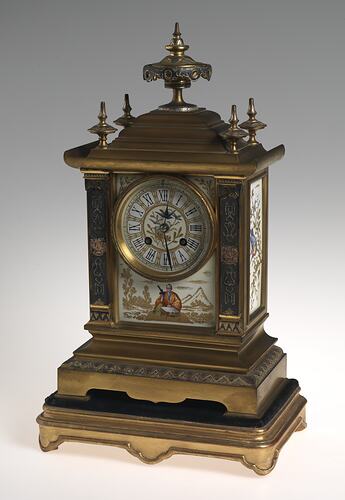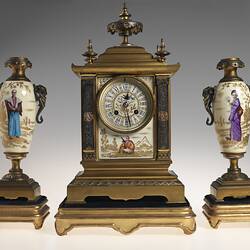Summary
Mantel clock from an ormolu garniture with Japonisme style decoration manufactured by Achille Brocot in France circa 1880. The other pieces in the garniture are two dummy candlesticks.
Paul Brocot (of the Achille Brocot clock manufacturing firm) exhibited in the French Court at the 1880 Melbourne International Exhibition, in Class 26 'Clocks and Watches'. He was awarded a First Order of Merit (silver) medal, for 'Mantel, Carriage, Ornamental and Ordinary Clocks', and a Third Order of Merit (certificate) for a 'second exhibit of special complicated clocks, of very high class'.
The Brocot display was just one of over 50 firms representing the French clock making industry. According to the Official Record, France exported between 25,000-30,000 clocks a year; England was its largest market at the time, and it was noted in the catalogue that Paul Brocot manufactured especially for the English and American markets. Brocot's display was described: 'This well-known maker exhibited an excellent collection of clocks, both simple and complicated. Among the latter were chime clocks, perpetual calender clocks, &c. The designs were most artistic, and workmanship of the first class. All these clocks had the Brocot Patent suspension of the pendulum.' (Official Record: 70)
Paul Brocot was a son of Achille Brocot (1817-1878), a mathematician and maker and inventor of clock mechanisms. Achille patented several improvements in clock mechanism escapements, and invented the 'Brocot Suspension', an adjustable pendulum spring which enabled time keeping to be regulated by altering the length of the pendulum suspension spring by a key turned in the dial. He also introduced a jeweled deadbeat escapement, sometimes called a visible escapement as it was often mounted in the middle of the dial. Achille was awarded a first class medal at the Paris Exhibition in 1855, and in 1856 was appointed Treasurer to La Société des Horlogers in Paris. He published a "Calculation of the Wheels by Approximation" in 1862. His sons Achille and Paul continued the business following Achille senior's death 1878. The firm was taken over by rival clock maker Gustave Gibaudet in 1889.
Physical Description
Enamelled panels on bronze clock. Circular face with glass cover hinged on left, with 12 roman numerals, decorated with blue birds and gilt flowers. The body of the clock is painted with a seated samurai in front of a mountain landscape. The side panels have colourful birds on branches. At the top of the clock are 5 finials. The clock is on a bronze pedestal with Grecian style moulding. The whole sits on a wood and gilded gesso base with a dark blue velvet top. Back of clock has circular door to workings.
More Information
-
Collection Names
-
Collecting Areas
-
Acquisition Information
Cultural Gifts Donation from Dr Will Twycross, 23 Jan 2009
-
Acknowledgement
Donated through the Australian Government's Cultural Gifts Program
-
Manufacturer
-
Exhibitor
Paul Brocot - Achille Brocot, Melbourne, Victoria, Australia, 1880-1881
-
Place & Date Exhibited
Royal Exhibition Building (REB), Nicholson Street, Carlton, Greater Melbourne, Victoria, Australia, 1880-1881
-
Collector
Mr John Twycross, Elsternwick, Greater Melbourne, Victoria, Australia, 1881
-
Inscriptions
Stamped into the metal of the clock mechanism are 'A.M' and in another area 'A*B' enclosed in an oval. Engraved on edge of clock bask and bottom of bronze pedestal: 8581, and below this, stamped: '584714'.
-
Classification
Royal exhibition building, International exhibitions, Exhibition heritage
-
Category
-
Discipline
-
Type of item
-
Dimensions
223 mm (Width), 128 mm (Depth), 385 mm (Height)
Measurement from conservation.
-
References
-
Keywords
Clocks, Decorative Arts, Exhibitions: Melbourne International, 1880-1881, Horology, Royal Exhibition Building








